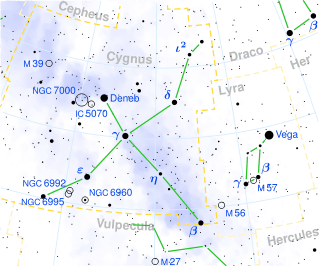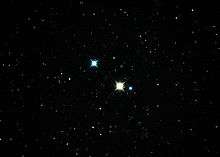31 Cygni
 | |
| Observation data Epoch J2000.0 Equinox J2000.0 | |
|---|---|
| Constellation | Cygnus |
| Right ascension | 20h 13m 37.907s[1] |
| Declination | +46° 44′ 28.78″[1] |
| Apparent magnitude (V) | 3.73 - 3.89[2] |
| Characteristics | |
| Spectral type | K4Iab + B4IV-V[2] |
| Variable type | Algol[2] |
| Astrometry | |
| Radial velocity (Rv) | –7.41 ± 0.08[3] km/s |
| Proper motion (μ) | RA: 4.78 ± 0.38[1] mas/yr Dec.: 1.21 ± 0.35[1] mas/yr |
| Parallax (π) | 3.69 ± 0.41[1] mas |
| Distance | approx. 880 ly (approx. 270 pc) |
| Orbit[3] | |
| Period (P) | 3786.1 ± 0.7 days |
| Eccentricity (e) | 0.224 ± 0.006 |
| Periastron epoch (T) | 2,452,372.8 ± 2.2 |
| Argument of periastron (ω) (secondary) | 206.4 ± 1.4° |
| Semi-amplitude (K1) (primary) | 13.78 ± 0.13 km/s |
| Details | |
| K supergiant | |
| Mass | 11.7 ± 1.3[4] M☉ |
| Radius | 197 ± 20[4] R☉ |
| Luminosity | 4,300 ± 1,100[5] L☉ |
| Temperature | 3,590 ± 225[5] K |
| B dwarf | |
| Mass | 7.1 ± 0.8[4] M☉ |
| Radius | 5.2 ± 0.5[4] R☉ |
| Temperature | 16500+1000 −2000[5] K |
| Other designations | |
| Database references | |
| SIMBAD | data |

31 Cygni, also known as ο1 Cygni, Omicron1 Cygni, or V695 Cygni, is a star in the constellation Cygnus.
The Bayer designation ο (omicron) has been variously applied to two or three of the stars 30, 31, and 32 Cygni. 31 Cygni has been designated, variously, as ο1 or ο2 Cygni — therefore for clarity, it is preferred to use the Flamsteed designation 31 Cygni.[6]
It is an Algol-type eclipsing binary and ranges between magnitudes 3.73 and 3.89 over a period of ten years. The component stars are an orange supergiant of spectral type K4Iab and a blue-white star likely to be evolving off the main sequence with a spectral type of B4IV-V.
30 Cygni is another naked eye star a tenth of a degree away, forming a bright triple.
32 Cygni is about a degree away to the north, also a detached eclipsing binary system. It comprises a large cool evolved star and a small hot main sequence or subgiant companion.
References
- 1 2 3 4 5 van Leeuwen, F. (2007). "Validation of the new Hipparcos reduction". Astronomy and Astrophysics. 474 (2): 653–664. arXiv:0708.1752. Bibcode:2007A&A...474..653V. doi:10.1051/0004-6361:20078357. Vizier catalog entry
- 1 2 3 Samus, N. N.; Durlevich, O. V.; et al. (2009). "VizieR Online Data Catalog: General Catalogue of Variable Stars (Samus+ 2007-2013)". VizieR On-line Data Catalog: B/gcvs. Originally published in: 2009yCat....102025S. 1. Bibcode:2009yCat....102025S.
- 1 2 Eaton, Joel A.; et al. (2008). "Orbits and Pulsations of the Classical ζ Aurigae Binaries". The Astrophysical Journal. 679 (2): 1490–1498. arXiv:0802.2238. Bibcode:2008ApJ...679.1490E. doi:10.1086/587452.
- 1 2 3 4 Eaton, Joel A. (1993). "31 Cygni: The B star and the wind". Astronomical Journal. 106: 2081. Bibcode:1993AJ....106.2081E. doi:10.1086/116787.
- 1 2 3 Di Benedetto, G. P.; Ferluga, S. (1990). "Angular diameters of Zeta Aurigae-type supergiants by Michelson interferometry". Astronomy and Astrophysics. 236: 449. Bibcode:1990A&A...236..449D.
- 1 2 Kostjuk, N. D. (2004). "VizieR Online Data Catalog: HD-DM-GC-HR-HIP-Bayer-Flamsteed Cross Index (Kostjuk, 2002)". VizieR On-line Data Catalog: IV/27A. Originally published in: Institute of Astronomy of Russian Academy of Sciences (2002). 4027. Bibcode:2004yCat.4027....0K.